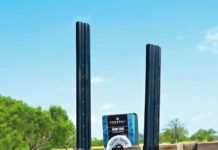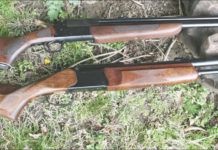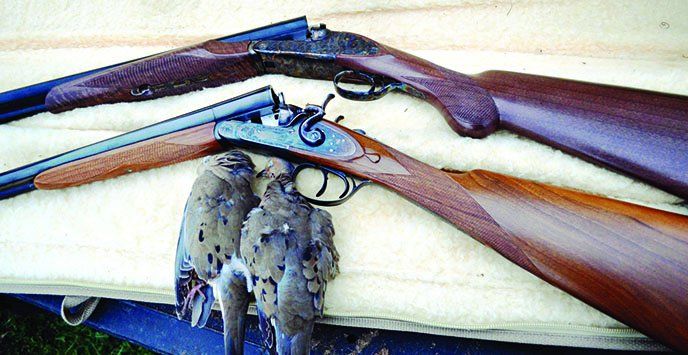
Every once in awhile, veteran shotgun enthusiasts might think back to the old days when hunting and target shooting proceeded at a slower pace, with a little more emphasis on fine form. Not that there is anything wrong with the quality over and under, semi-automatic, or pump-action shotguns on today’s market, but in many minds, the old side-by-sides just give off an image of a little more class. A lot of today’s veteran hunters started their shooting careers with an old double barrel handed down to them by their father or grandfather. Unfortunately, many of those old side-by-sides kicked like a mule and had so much drop in the stock that the shooter really had to work at obtaining a proper sight picture to hit anything.
Times have changed, and now the younger generation seems to have adjusted to modern technology with new model scatterguns that are easier to shoot and handle. Fine side-by-sides are few and far between on today’s field and clay target ranges, but they have not been totally forgotten. We decided to jump into our time machine and take a little venture back to the days when side-by-sides were king. To cover the bases and pit old versus new within a reasonable price framework, we selected a used old-style SIACE Model 350G with double hammers and double triggers, available for about $2,000; and a recently introduced CZ-USA Ringneck hammerless with a single trigger, retailing for $1,022. Both of the doubles were 20-gauge models with screw-in internal chokes.
As most shooting instructors will point out, shooting a side-by-side can be a little more difficult to master than shooting down a single-barrel sight plane. The wider two-barrel image can be a distraction for a shooter who should be focusing on the target. If you are looking at the barrel and not the target, chances are the shot string will not be in the right place at the right time, and you’ll miss.
In many cases, a shooter will slightly lift his or her head off the stock of a side-by-side when taking a shot (also related to having a wider sight plane and other design features of the double guns) causing the shot to go high. Shooting a little high is fine for flushing quail, grouse or pheasants, but can play havoc with a clay target score.
A similar shooter adjustment is required when the firearm features double triggers rather than a single trigger. When the front trigger only fires the right barrel and the back trigger only fires the left barrel, the shooter has to remember to switch from front to back to touch off two shots. With practice, this switching procedure is not a problem, but for double-trigger newbies, there is most definitely potential for confusion.
Although each of the 20-gauge double guns were designed to handle up to 3-inch shells, we decided to limit our test ammunition to lighter loads, with the understanding that increased recoil can be a major factor when shooting lighter side-by-sides. Our test ammunition included Noble Target Trap 2.75-inch loads, 2.5 dram equivalent, packing 7/8 ounce of No. 7.5 shot with an average muzzle velocity of 1,210 fps; and Federal Game 2.75-inch loads, 2.5 dram equivalent, with 7/8 ounce of No. 7.5 shot with an average muzzle velocity of 1,210 fps. The only ammunition malfunction we encountered was with a single Federal shell that had its primer seated too deep for the firing pin of either of the side-by-sides to touch off. Here are the rest of our findings:
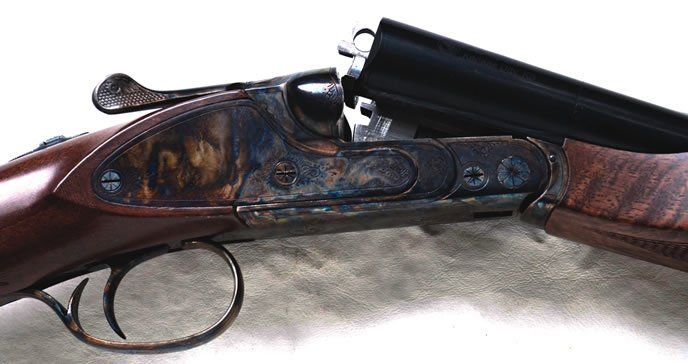
CZ-USA Ringneck Side-by-Side
No. 06103 20 Gauge, $1,022
Advertised as an economical side-by-side meeting the need of upland-game hunters and designed specifically to handle flushing birds like quail or grouse, the CZ Ringneck is already in limited production due to the introduction of the new CZ Bobwhite model. That is just how fast the firearms market can change, which is both good news and bad news for scattergun enthusiasts.
We found our test model was both pleasing to the eye and had a fine heft that was comparable to the big bore of the family, a 12 gauge. The 20-gauge Ringneck is built on a proportionate frame that helps make it handle like a smooth shooting tool.
Although the Turkish walnut stock was plain, not a lot of grain or swirl in the wood, we liked the look of the forearm. The hand-checkered Prince of Wales-style grip that was rounded at the bottom was cut 20 lines to the inch and provided a good grip. However, the checkering on our model’s semi-beavertail with Schnabel tip was not as sharp and was a little flat for our taste.
The case-hardened box-lock receiver and trigger guard was a nice touch on what is considered a field gun.
Tipping the scales at 6.25 pounds, we found the heft and smoothness of the shotgun to be quite a pleasure. With 28-inch barrels and an overall length of 45.25 inches, the Ringneck had a length of pull of 14.5 inches, a drop at the comb of 1.75 inches, and a drop at the heel of 2.75 inches. Our team had no problems adjusting to the fit.
On the down side, when we tested the pull of the mechanical triggers, we found the right barrel touched off at 8.5 pounds and the left barrel touched off at 10 pounds. Both pulls are too heavy for smooth performance with a scattergun. Even allowing for the stiffness of a new gun, we would recommend a trip to a gunsmith to adjust the triggers down to a more preferable touch off of about 5 pounds.
Another feature that fell into the unnecessarily stiff category was the Greener cross-bolt locking system. On several occasions, the back end of the bolt was still slightly exposed when the action was closed and the top lever did not return to center. The shotgun was still operable, and after several hundred rounds there appeared to be a much better bolt fit.
On both the dove field and the clay target range we found the Ringneck would do its job without any malfunctions and very little felt recoil. As noted earlier, a little adjustment is necessary to switch from looking over a single barrel to sighting along a side-by-side, but once the brief adjustment period was over, putting the Ringneck on target was quite easy.
Patterning the double barrel on paper with the Noble ammunition, we discovered one of the reasons our shooting performance was better than average. At a range of 30 yards and using the Modified choke in the left barrel, the CZ produced a very solid 50/50 pattern (50 percent above the center and 50 percent below) within a 30-inch circle. Inside the 20-inch circle at the center of the target there were 196 of the 296 pellet hits for a solid center punch of 66 percent. This performance was the best of all our patterning tests.
With the improved cylinder choke in the right barrel, the Ringneck was a little less impressive, with a 37/63 pattern and 108 of the 187 hits in the 20-inch circle. There were three 3-inch holes in the overall spread that would have allowed a clay target or bird to escape untouched.
The CZ Ringneck comes with five internal chokes (Cylinder, Improved Cylinder, Modified, Improved Modified, and Full), and we would recommend that any new owner spend a little time on the patterning range to find out the best combination of choke and shot load for his particular shotgun. That practice also takes away the excuse of blaming a shotgun for the shooter missing targets.
Our Team Said: We were particularly pleased with the heft and balance of the CZ Ringneck, which had a more solid feel than the SIACE, our shooters said. Not having to adjust to double hammers and double triggers made the shotgun a little easier to use for the less experienced members of our test team, although the difference was not considered a major issue. The excellent patterning performance with the Modified choke was big plus, as was the slightly heavier weight that helped our shooters swing smoothly through targets.
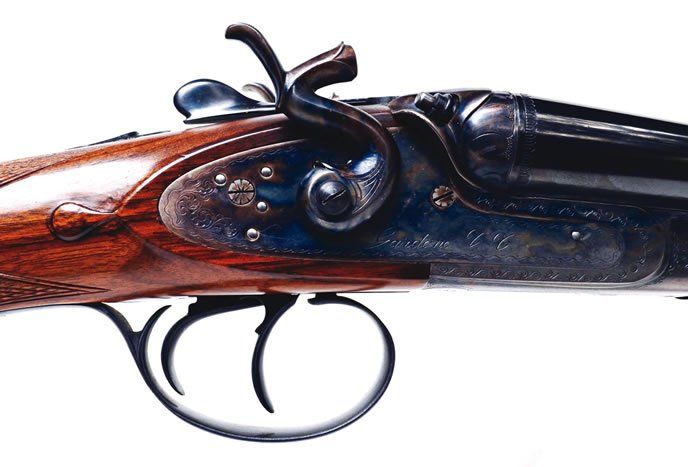
SIACE Model 350G
Side By Side Hammer Gun
20 Gauge, $2,000
A touch of class radiates from this tiny double that was made by SIACE in Italy during 1999 for resale in the U.S. by New England Arms of Kittery Point, ME. The solid snap as the hammers are pulled back into place is like music to the ears of veteran scattergun enthusiasts remembering the old days. With a hand-engraved, case-hardened side lock receiver and hammers, plus a checkered opening lever; and the hand-checkered English-style straight grip stock of Grade 2 wood, the 350G’s eye appeal was a big plus in this match-up.
Very slim and trim, the SIACE offers 29-inch barrels threaded for Briley thin-wall chokes (two Skeet, one Improved Cylinder, one Light Modified, and one Modified) that help make the shotgun surprisingly light at just 6 pounds. With an overall length of 46 inches, a drop at the comb of 2.0 inches and drop at the heel of 3.25 inches, our shooters needed a little more adjustment time to get the shotgun to shoot where we were looking. The additional drop in the stock is typical of the old-style side-by-sides put into service by U.S. shooters.
Another old-style feature was the stock’s butt plate, which was just hand-checkered wood rather than a plastic or rubber recoil pad. As we expected, felt recoil was just a little heavier with the SIACE because of both the lighter weight and the lack of a recoil pad, but we did not consider this a deal breaker. The SIACE trigger pull was also a little heavier than we like, with the right barrel touching off at 7 pounds and the left barrel touching off at 6.25 pounds. They were lighter than the Ringneck, but still more than the preferred touch off of about 5 pounds.
During our ventures onto the dove field and sporting clays range, we found the SIACE was a little harder to bring to bear on the targets. The shotgun is set up to handle rising birds such as quail and grouse, with our team having good success at those types of targets. High incomers and sharp crossing targets were a little different story; a good deal of practice was required before any consistency could be achieved.
Cocking the hammers to get ready for a shot and then switching from the front trigger to the back trigger took a little adjustment time. Some team members struggled a little more than others, but we did not find cocking the hammers each time and switching triggers to be major obstacles in smooth operation of the shotgun.
Moving onto the patterning range, we found that the after-market Briley chokes did not fare as well as the factory internal chokes that came with the Ringneck. The Modified choke in the left barrel produced a 34/66 percent pattern with 153 hits (61 percent) in the 20-inch center.
However, there were three 3-inch holes in the pattern. With the Improved Cylinder choke in the right barrel, the result was a 33/67 percent pattern with 86 hits in the 20-inch center and four 3-inch holes. Both barrels of the SIACE seemed to shoot slightly low left on the 30-inch pattern, which could be the main reason more adjustment time was necessary to make target hits. Once again, we recommend spending practice time on the patterning range to find the right combination of chokes and ammunition for your specific shotgun.
As noted earlier, we were expecting a little more recoil from the SIACE, and our expectations proved to be correct. The higher felt recoil was noticeable, particularly with the smaller-framed members of our shooting team.
Our Team Said: This double barrel more closely resembles what we picture when reflecting on the classic SxS of the old days. Double hammers and double triggers did require a little adjustment time, and the SIACE was just a little whippy. However, if a shooter is determined to take a trip back to the days of tweed shooting jackets and high-topped boots, this little side-by-side would be an excellent companion.
Written and photographed by Ralph Winingham, using evaluations from Gun Tests team testers. GT


























